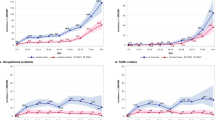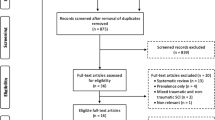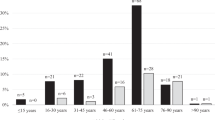Abstract
Study design:
Cohort study.
Objectives:
To provide recent estimates of the incidence of traumatic spinal cord injury (SCI) in adults living in Ontario.
Setting:
Ontario, Canada.
Methods:
The study included all men and women aged 18 years and older living in Ontario. The two primary data sources used for this study were the census data provided by Statistics Canada and the hospital Discharge Abstract Database (DAD) provided by the Canadian Institute for Health Information. Incidence was estimated for the fiscal years 2003/04–2006/07, and examined by age, gender, mechanism and seasonality of injury, the level of injury, the presence of comorbidity and in-hospital mortality.
Results:
The incident cases had a mean age of 51.3 years (s.d. 20.1). The majority of the cases was male (74.1%) and had a cervical SCI caused by falls (49.5%). The age-adjusted incidence rate was stable over the 4-year study period, from 24.2 per million (95% CI: 21.2–27.6) in 2003 to 23.1 per million (95% CI: 20.2–26.3) in 2006.
Conclusion:
Despite worldwide trends that have indicated motor vehicle collisions (MVCs) as the leading cause of injury, falls emerged as the leading cause of traumatic SCI in this study. This finding, and the fact that the number of fall-induced injuries increased steadily with age, may indicate that there is growing concern for the consequences of falls in the elderly. Further work is needed to understand this trend in age and gender and the causes of falls to develop effective fall prevention strategies.
Similar content being viewed by others
Log in or create a free account to read this content
Gain free access to this article, as well as selected content from this journal and more on nature.com
or
References
Sekhon LH, Fehlings MG . Epidemiology, demographics, and pathophysiology of acute spinal cord injury. Spine 2001; 26 (24 Suppl): S2–S12.
McKinley WO, Jackson AB, Cardenas DD, DeVivo MJ . Long-term medical complications after traumatic spinal cord injury: a regional model systems analysis. Arch Phys Med Rehabil 1999; 80: 1402–1410.
Berlly M, Shem K . Respiratory management during the first five days after spinal cord injury. J Spinal Cord Med 2007; 30: 309–318.
Smith BM, Evans CT, Kurichi JE, Weaver FM, Patel N, Burns SP . Acute respiratory tract infection visits of veterans with spinal cord injuries and disorders: rates, trends, and risk factors. J Spinal Cord Med 2007; 30: 355–361.
Siddall PJ, McClelland JM, Rutkowski SB, Cousins MJ . A longitudinal study of the prevalence and characteristics of pain in the first 5 years following spinal cord injury. Pain 2003; 103: 249–257.
Pickett GE, Campos-Benitez M, Keller JL, Duggal N . Epidemiology of traumatic spinal cord injury in Canada. Spine 2006; 31: 799–805.
Garshick E, Kelley A, Cohen SA, Garrison A, Tun CG, Gagnon D et al. A prospective assessment of mortality in chronic spinal cord injury. Spinal Cord 2005; 43: 408–416.
DeVivo MJ . Causes and costs of spinal cord injury in the United States. Spinal Cord 1997; 35: 809–813.
Dryden DM, Saunders LD, Jacobs P, Schopflocher DP, Rowe BH, May LA et al. Direct health care costs after traumatic spinal cord injury. J Trauma 2005; 59: 443–449.
French DD, Campbell RR, Sabharwal S, Nelson AL, Palacios PA, Gavin-Dreschnack D . Health care costs for patients with chronic spinal cord injury in the Veterans Health Administration. J Spinal Cord Med 2007; 30: 477–481.
Woolhandler S, Himmelstein DU . Double catastrophe: injury-related bankruptcies. Med Care 2007; 45: 699–701.
Hollingworth W, Relyea-Chew A, Comstock BA, Overstreet JK, Jarvik JG . The risk of bankruptcy before and after brain or spinal cord injury: a glimpse of the iceberg's tip. Med Care 2007; 45: 702–711.
Fisher CG, Noonan VK, Dvorak MF . Changing face of spine trauma care in North America. Spine 2006; 31 (11 Suppl): S2–S8; discussion S36.
Wyndaele M, Wyndaele JJ . Incidence, prevalence and epidemiology of spinal cord injury: what learns a worldwide literature survey? Spinal Cord 2006; 44: 523–529.
Ho CH, Wuermser LA, Priebe MM, Chiodo AE, Scelza WM, Kirshblum SC . Spinal cord injury medicine. 1. Epidemiology and classification. Arch Phys Med Rehabil 2007; 88 (3 Suppl 1): S49–S54.
Jackson AB, Dijkers M, Devivo MJ, Poczatek RB . A demographic profile of new traumatic spinal cord injuries: change and stability over 30 years. Arch Phys Med Rehabil 2004; 85: 1740–1748.
National Center for Health Statistics. Injury ICE Activities. Available at: http://www.cdc.gov/nchs/about/otheract/ice/matrix10sas.htm. Accessed June 10, 2008.
Pickett W, Simpson K, Walker J, Brison RJ . Incidence of traumatic spinal cord injury in Ontario, Canada. J Trauma 2003; 55: 1070–1076.
Kannus P, Parkkari J, Koskinen S, Niemi S, Palvanen M, Järvinen M et al. Fall-induced injuries and deaths among older adults. JAMA 1999; 281: 1895–1899.
Acknowledgements
This research was supported by a grant from the Ontario Neurotrauma Foundation (ONF). Dr Jaglal is the Toronto Rehabilitation Institute Chair at the University of Toronto in Health Services Research. Dr Couris postdoctoral fellowship was supported by the Toronto Rehabilitation Institute and the University of Toronto. We acknowledge the support of Toronto Rehabilitation Institute that receives funding under the Provincial Rehabilitation Research Program from the Ministry of Health and Long-Term Care in Ontario. The views expressed do not necessarily reflect those of the Ministry.
Author information
Authors and Affiliations
Corresponding author
Appendix A
Appendix A
Traumatic SCI ICD-10-CA codes (obtained from Rick Hansen Foundation), stratified by level of injury
Note: All these ICD10 diagnosis codes have been checked for evolution.
Rights and permissions
About this article
Cite this article
Couris, C., Guilcher, S., Munce, S. et al. Characteristics of adults with incident traumatic spinal cord injury in Ontario, Canada. Spinal Cord 48, 39–44 (2010). https://doi.org/10.1038/sc.2009.77
Received:
Revised:
Accepted:
Published:
Issue date:
DOI: https://doi.org/10.1038/sc.2009.77
Keywords
This article is cited by
-
Quality of in-hospital care in traumatic spinal column and cord injuries (TSC/SCI) in I.R Iran
European Spine Journal (2024)
-
Epidemiological features of traumatic spinal cord injury in Wuhan, China
Journal of Orthopaedic Surgery and Research (2023)
-
Current state of fall prevention and management policies and procedures in Canadian spinal cord injury rehabilitation
BMC Health Services Research (2020)
-
Reactive stepping after a forward fall in people living with incomplete spinal cord injury or disease
Spinal Cord (2020)
-
International Standards for Neurological Classification of Spinal Cord Injury: factors influencing the frequency, completion and accuracy of documentation of neurology for patients with traumatic spinal cord injuries
European Journal of Orthopaedic Surgery & Traumatology (2019)



